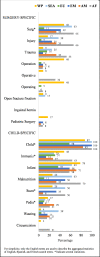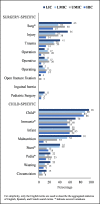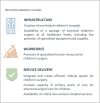Global and regional overview of the inclusion of paediatric surgery in the national health plans of 124 countries: an ecological study
- PMID: 34135040
- PMCID: PMC8211076
- DOI: 10.1136/bmjopen-2020-045981
Global and regional overview of the inclusion of paediatric surgery in the national health plans of 124 countries: an ecological study
Abstract
Objective: This study evaluates the priority given to surgical care for children within national health policies, strategies and plans (NHPSPs).
Participants and setting: We reviewed the NHPSPs available in the WHO's Country Planning Cycle Database. Countries with NHPSPs in languages different from English, Spanish, French or Chinese were excluded. A total of 124 countries met the inclusion criteria.
Primary and secondary outcome measures: We searched for child-specific and surgery-specific terms in the NHPSPs' missions, goals and strategies using three analytic approaches: (1) count of the total number of mentions, (2) count of the number of policies with no mentions and (3) count of the number of policies with five or more mentions. Outcomes were compared across WHO regional and World Bank income-level classifications.
Results: We found that the most frequently mentioned terms were 'child*', 'infant*' and 'immuniz*'. The most frequently mentioned surgery term was 'surg*'. Overall, 45% of NHPSPs discussed surgery and 7% discussed children's surgery. The majority (93%) of countries did not mention selected essential and cost-effective children's procedures. When stratified by WHO region and World Bank income level, the West Pacific region led the inclusion of 'pediatric surgery' in national health plans, with 17% of its countries mentioning this term. Likewise, low-income countries led the inclusion of surg* and 'pediatric surgery', with 63% and 11% of countries mentioning these terms, respectively. In both stratifications, paediatric surgery only equated to less than 1% of the total terms.
Conclusion: The low prevalence of children's surgical search terms in NHPSPs indicates that the influence of surgical care for this population remains low in the majority of countries. Increased awareness of children's surgical needs in national health plans might constitute a critical step to scale up surgical system in these countries.
Keywords: health policy; paediatrics; surgery.
© Author(s) (or their employer(s)) 2021. Re-use permitted under CC BY-NC. No commercial re-use. See rights and permissions. Published by BMJ.
Conflict of interest statement
Competing interests: None declared.
Figures




Similar articles
-
Prioritization of Surgical, Obstetric, Trauma, and Anesthesia Care in South and Southeast Asian Countries' Health Planning and Policy‑making: SOTA Care Policies in South and Southeast Asia.Ann Glob Health. 2024 Dec 11;90(1):80. doi: 10.5334/aogh.4532. eCollection 2024. Ann Glob Health. 2024. PMID: 39678202 Free PMC article.
-
The Need for Children's Surgical Care Prioritisation in National Surgical Care Policies: A Systematic Review of National Surgical Obstetric and Anaesthetic Plans (NSOAPs) in Sub-Saharan Africa.J Pediatr Surg. 2024 Feb;59(2):299-304. doi: 10.1016/j.jpedsurg.2023.10.040. Epub 2023 Nov 8. J Pediatr Surg. 2024. PMID: 38135547
-
Prioritisation of surgery in the National Health Strategic Plans of Africa: a systematic review.Lancet. 2015 Apr 27;385 Suppl 2:S53. doi: 10.1016/S0140-6736(15)60848-0. Epub 2015 Apr 26. Lancet. 2015. PMID: 26313103
-
The Global Initiative for Children's Surgery: Optimal Resources for Improving Care.Eur J Pediatr Surg. 2018 Feb;28(1):51-59. doi: 10.1055/s-0037-1604399. Epub 2017 Aug 14. Eur J Pediatr Surg. 2018. PMID: 28806850
-
Comparative content analysis of national health policies, strategies and plans before and after COVID-19 among OECD and BRICS countries.Glob Health Res Policy. 2025 Feb 21;10(1):6. doi: 10.1186/s41256-024-00400-y. Glob Health Res Policy. 2025. PMID: 39985012 Free PMC article.
Cited by
-
An analysis of the inclusion of ear and hearing care in national health policies, strategies and plans.Health Policy Plan. 2023 Jun 16;38(6):719-725. doi: 10.1093/heapol/czad026. Health Policy Plan. 2023. PMID: 37130061 Free PMC article.
-
Building back better children's surgical services toward universal health coverage: Perspectives from Bangladesh and Zimbabwe.Front Public Health. 2023 Jan 25;11:1073319. doi: 10.3389/fpubh.2023.1073319. eCollection 2023. Front Public Health. 2023. PMID: 36761126 Free PMC article.
-
A review of twenty-first century developments in paediatric surgery in Africa.Pediatr Surg Int. 2024 May 23;40(1):137. doi: 10.1007/s00383-024-05718-9. Pediatr Surg Int. 2024. PMID: 38780635 Review.
-
Systematic Review of the Prevalence of Gastrointestinal Congenital Anomalies: A Global and Regional Review Protocol.Sage Open Pediatr. 2025 Mar 27;12:30502225251283177. doi: 10.1177/30502225251283177. eCollection 2025 Jan-Dec. Sage Open Pediatr. 2025. PMID: 40612197 Free PMC article. Review.
-
Do health policies address the availability, accessibility, acceptability, and quality of human resources for health? Analysis over three decades of National Health Policy of India.Hum Resour Health. 2021 Nov 13;19(1):139. doi: 10.1186/s12960-021-00681-1. Hum Resour Health. 2021. PMID: 34774088 Free PMC article.
References
-
- Price R, Makasa E, Hollands M. World Health Assembly Resolution WHA68.15: "Strengthening Emergency and Essential Surgical Care and Anesthesia as a Component of Universal Health Coverage"—Addressing the Public Health Gaps Arising from Lack of Safe, Affordable and Accessible Surgical and Anesthetic Services. World J Surg 2015;39:2115–25. 10.1007/s00268-015-3153-y - DOI - PubMed
MeSH terms
LinkOut - more resources
Full Text Sources
Miscellaneous
